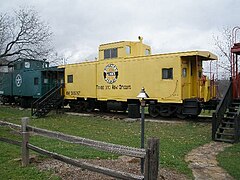
Llano County is a county located on the Edwards Plateau in the U.S. state of Texas. As of the 2020 census, its population was 21,243. Its county seat is Llano, and the county is named for the Llano River.

Grand Canyon Village is a census-designated place (CDP) located on the South Rim of the Grand Canyon, in Coconino County, Arizona, United States. Its population was 2,004 at the 2010 Census. Located in Grand Canyon National Park, it is wholly focused on accommodating tourists visiting the canyon. Its origins trace back to the railroad completed from Williams, to the canyon's South Rim by the Santa Fe Railroad in 1901. Many of the structures in use today date from that period. The village contains numerous landmark buildings, and its historic core is a National Historic Landmark District, designated for its outstanding implementation of town design.

Kingsland is a census-designated place (CDP) in Llano County, Texas, United States. The population was 6,030 at the 2010 census, up from 4,584 at the 2000 census. Texas Ranch to Market Road 1431 runs through the community.

Llano is a city in Llano County, Texas, United States. As of 2010, the city population was 3,232. It is the county seat of Llano County. Llano has been described as the "deer capital of Texas", with the single highest density of white-tailed deer in the United States.
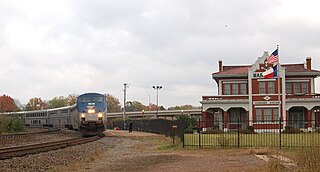
Marshall station is a railroad station in Marshall, Texas. It is served by Amtrak, the national railroad passenger system, which operates the Texas Eagle through Marshall each day, with service north to Chicago and west-southwest to Dallas, San Antonio and Los Angeles. The station also houses the Texas and Pacific Railway Depot & Museum.
These historic properties and districts in the state of Texas are listed in the National Register of Historic Places. Properties and/or districts are listed in most of Texas's 254 counties.
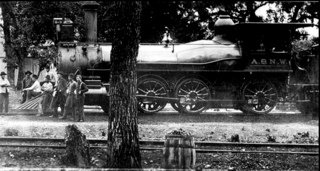
The Austin and Northwestern Railroad began construction on a rail line west of Austin, Texas, USA, toward Llano on April 20, 1881. The railroad was originally built as a 3 ft narrow gauge line with plans to connect to the Texas and Pacific Railway at Abilene. Construction reached Burnet, Texas, by 1882 and the line was later extended to Granite Mountain by 1885 - when the railroad was contracted to haul pink granite for the new Texas State Capitol building in Austin. The company later extended its line 2.3 miles (3.7 km) to Marble Falls by using the charter of the Granite Mountain and Marble Falls City Railroad. Due to a bend in the tracks, trains would occasionally derail, accidentally dumping some of the pink granite. The rocks which remain are a local point of interest.
Antlers Hotel may refer to:

The Austin Western Railroad is a short-line railroad headquartered in Round Rock, Texas. AWRR is a subsidiary of Watco.

The Grand Lake Lodge hotel was opened in 1920 to serve tourists visiting Rocky Mountain National Park via the Trail Ridge Road, completed the same year. Located in Grand Lake, Colorado, the rustic lodge was founded by Frank Huntington and Roe Emery on land owned by the National Park Service at the edge of the park. The resort was affiliated with the Chicago, Burlington & Quincy Railroad.
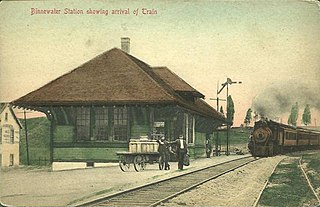
The Binnewater Historic District is a national historic district located at Rosendale in Ulster County, New York, United States. The district originally included nine contributing buildings built during the late 19th and early 20th centuries. They were all frame structures and included a railroad depot, a privy, a general store that was also a post office, a livery stable, two houses, a wagon shed, and two barns. The general store served as an unofficial railroad depot for the Wallkill Valley Railroad from 1875 until 1883, when the railroad constructed the actual station. The station was located too close to Binnewater Road, and was hit repeatedly by trucks. In May 1989, a large piece of the building broke off and fell into the street. The structure was subsequently demolished.
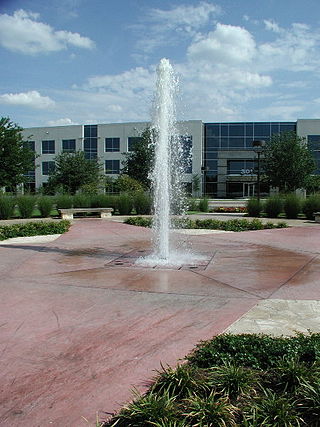
La Frontera is a mixed-use development in Round Rock, Texas. It consists of retail, residential and office properties. The name "La Frontera" means "the border" or "frontier" in Spanish, referring to the development's location on the border of Travis and Williamson counties.
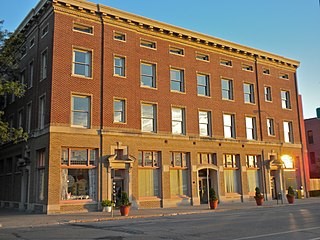
The Northwestern Hotel is an historic building located in the East Village of Des Moines, Iowa, United States. It was listed on the National Register of Historic Places in 1984. In 2017 it was included as a contributing property in the East Des Moines Industrial Historic District.
The Central of Tennessee Railway and Navigation Company is a defunct railroad company in Tennessee, United States. Centennrail began railroad freight operations on June 19, 1992.

The Antlers is a Wyndham Hotel located in Colorado Springs, Colorado. It opened in 1967 and is the third hotel of that name on the same site.

Evergreen Conference District is a music conference center in Jefferson County, Colorado, near Evergreen. It was listed as a historic district on the National Register of Historic Places on May 1, 1979. The district is located at Highway 74 along Bear Creek.

The Austin and Northwestern Railroad Historic District-Fairland to Llano is a 380-acre (1.5 km2) historic district in Burnet County and Llano County, Texas, United States. It was listed on the National Register of Historic Places in 1997. The listing included four contributing buildings, 43 contributing structures, and three contributing sites.

Historic Hotels of America is a program of the National Trust for Historic Preservation that was founded in 1989 with 32 charter members; the program accepts nominations and identifies hotels that have maintained their authenticity, sense of place, and architectural integrity. In 2015, the program included over 260 members in 44 states, including the District of Columbia, Puerto Rico, and the U.S. Virgin Islands. In 2022, the program includes 273 hotels. This article lists current and former member hotels.




